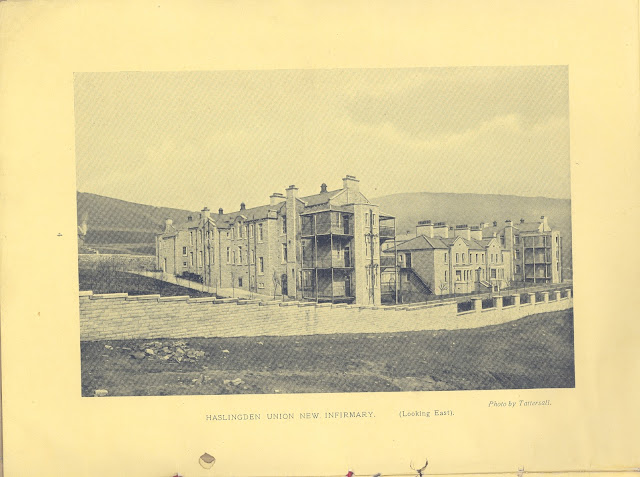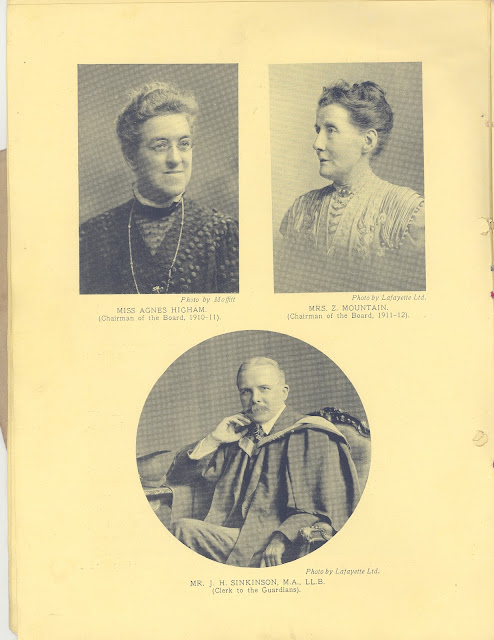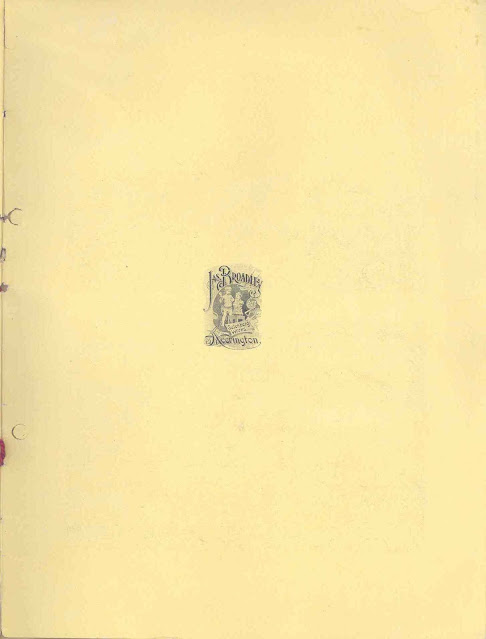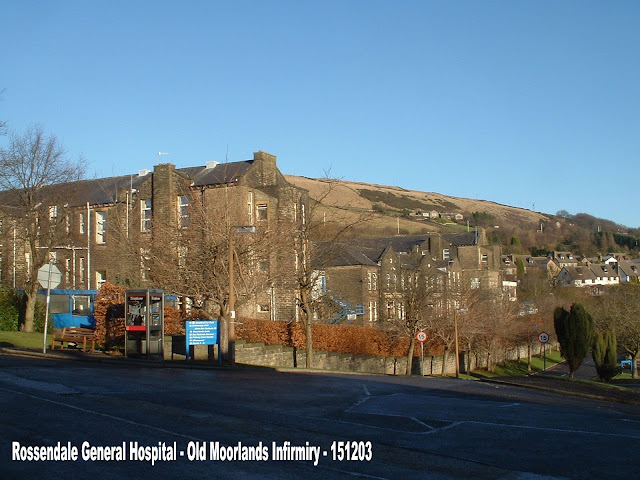We are starting off with scans of the booklet called HASLINGDEN UNION - OUTLINE - of the administrative work of the HASLINGDEN BOARD OF GUARDIANS and DESCRIPTIVE ACCOUNT of the Haslingden Union New Infirmary, Opened on Saturday 13th July 1912 by the Right Honourable JOHN BURNS, MP., President of the Local Government Board.
PLEASE CLICK OVER THE SCANS BELOW TO ENLARGE
1.
The first Workhouse on Lower Lane
(Lower Lane lies between Church Street and Hud Rake and also accessed from Spring Lane)
(Not sure but told the building was eventually taken over by Baxters Brewery, but as yet not confirmed)
The Union inherited two workhouses from the parish authorities - Lower Lane, Haslingden built in 1749, and Newchurch. In 1848, Haslingden Workhouse, which had an average of 64 Inmates that year, was in the sole charge of a master and matron, whose annual salary was £30 plus food and accomodation. The building was so small and so ill-furnished that almost every regulation of the Poor Law Board was broken. An inspecter complained in 1849 that the inmates suffering from fever "the itch" and venereal diseases were in the same ward as the ordinary sick and the infirm. There was no separation of men and boys or of women and girls; and according to an inspector who paid a visit in 1851, the door between the male and female sleeping quarters was kept unlocked at night. Following his report, the Guardians decided to use Haslingden Workhouse for women and children, an arrangement that continued until the Pike Low Institution (Moorlands) was opened in 1870.
In 1860, an inmate of the Haslingden Workhouse, a self-respecting man who had fallen on evil days, protested in a letter to the Poor Law Board that he had been forced to sleep with a lousy pauper. He also complained that old, blue milk given to the inmtes was often so sour in summer that it was frequently left untouched. The Workhouse dinner, he added was "hasty pudding" which was the porridge left over from breakfast made up with flour and sweetened with a little treacle. By 1867, however the diet had been so greatly improved that the Poor Law Board asked the Guardians to consider whether or not it was too good for "persons of the class for whom it is intended".
The only event to which the inmates of the workhouse could look forward was their Christmas dinner. From 1853 until 1860, a group of townspeople provided roast beef and plum pudding; thereafter the dinner and a supply of beer were paid for out of the Poor Rate. At the dinner in 1857, "Blind Tom" Barnes played some joyous music on an old piano".
Photo: of Blind Tom Barnes
A few Bibles and a copy of Hall's Morning and Evening Devotions were the only books for the paupers to read. In 1864, however the Guardians asked the Lancashire and Yorkshire Railway Company for permission to place on local stations boxes into which travellers could place old books and periodicals for the inmates. Eight years later the Guardians learned with surprise that one of the boxes had been filled.
In February, 1870 the Haslingden paupers marched from the old workhouse to the new Pike Low Institution. At their head was "Blind Tom" Barnes playing on his flute "See the Conquering Hero Comes." The opening of Pike Low, says Boyson
marked the greatest single advance in the Haslingden Union's administration of indoor relief. At one stroke many old abuses disappeared. The Poor Law Board had gained many victories, but they had frequently been victories of principle only. The Guardians had often agreed with the wisdom of central rulings, such as those regarding the greater segregation of inmates, but they had always been able to plead that the workhouses were too overcrowded to allow these rulings to be carried into effect.
This excuse would no longer suffice. The greatest victory of the Poor Law Board had been the building of the new workhouse, which in itself changed the whole psychological setting. The Guardians became almost enthusiastic about their new workhouse and became a little more like partners, rather than opponents of the Board.
(we are indebted to Chris Aspin and also to the late Rhodes Boyson M.P. to draw from their excerpts taken from "The Haslingden Poor Law Union, 1848-1930 (unpublished thesis) and Chris Aspins book "Haslingden" 1800 to 1900.
2.
The Workhouse
Pike Low Institution (Moorlands) was opened in 1870.
(The building we came to know much later as part
of the Rossendale General Hospital)
The opening of Pike Low, says Boyson
marked the greatest single advance in the Haslingden Union's administration of indoor relief. At one stroke many old abuses disappeared. The Poor Law Board had gained many victories, but they had frequently been victories of principle only. The Guardians had often agreed with the wisdom of central rulings, such as those regarding the greater segregation of inmates, but they had always been able to plead that the workhouses were too overcrowded to allow these rulings to be carried into effect.
This excuse would no longer suffice. The greatest victory of the Poor Law Board had been the building of the new workhouse, which in itself changed the whole psychological setting. The Guardians became almost enthusiastic about their new workhouse and became a little more like partners, rather than opponents of the Board.
Some abuses remained, however, and only two years after the opening of the new workhouse, an inspector found the children in a "scandalous" condition. Out of 19 in the workhouse, two were of school age and the rest were in great need of care. A woman awaiting confinement for an illigitimate child was supposed to look after them. The Medical Officer told the inspector that a child had recently died from want of care and another was likely to become an imbecile for the same reason. The Guardians answer to this problem was to recruit a supply of child-minders by the simple expedient of refusing outdoor relief to young women deserted by their husbands. It was 1895 before a nurse was appointed to superintend the children's and laying-in wards.
Staff at the new workhouse were often chosen from among unsatisfactory candidates. A master was dismissed in 1871 for drinking the wine provided for sick inmates, and several nurses, attendants and porters were replaced because of their drunkenness and immortality.
From 1848 until 1873, the Guardians were responsible for public health, but though Boyson says they appeared enthusiastic about their work, frequently calling for reports from their nuisance inspectors and medical officers, and discussing at least one nuisance at each meeting, serious complaints were often made. The Blackburn Weekly Times commented in December
(we are indebted to Chris Aspin and also to the late Rhodes Boyson M.P. to draw from their excerpts taken from "The Haslingden Poor Law Union, 1848-1930 (unpublished thesis) and Chris Aspins book "Haslingden" 1800 to 1900.
(Above) A more recent photo from 2003
(below) Census Records for the Haslingden Union Workhouse first set for (1871)
Please make sure you click over the scan to enlarge
(We are indebted to Jackie for coming up with these old census)(below) Census Records for the Haslingden Union Workhouse 2nd set for (1881)
Please make sure you click over the scan to enlarge
3.
Haslingden Union - Opening of the New Workhouse Infirmary
The above documents were kindly donated by Miss Taylor and also the late Alderman Joyce Thorne for inclusion of the Haslingden Old and New Blog
4.
Pike Law Military Hospital
Thanks to Wadey for sharing this photo
5
Moorlands Infirmary
Click over to enlarge
Click over to enlarge
Rossendale General Hospital


































































